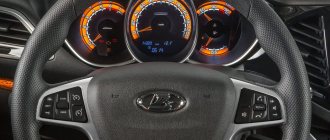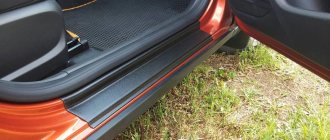Not long ago, a test drive of the Lada Vesta took place by Anton “Avtoman” Vorotnikov, a fairly prominent figure in the life and coverage of the Russian automobile industry. This driver has his own YouTube channel, where he regularly posts videos and photos of his personal experience testing a particular car model.
Anyone can watch an honest and thorough video review online by entering a search query about Lada Vesta and Anton “Avtomat” (some mistakenly call it that way) into the search bar in the browser. What he saw is really worth watching: the biography of the presenter, related to auto mechanics, speaks of his incredible ability to quickly detect any shortcomings of the car, while competently and correctly highlighting the advantages. An objective look at the new AvtoVAZ product will allow you to more accurately judge the Lada Vesta.
Read more about the review
The activity of Anton Vorotnikov, like his colleague and direct competitor Zhorik Revazov, is to objectively show the car enthusiast what to expect from a particular car model. Vorotnikov's review includes a fairly extensive test drive to check the technical characteristics of the car and detect possible problems - in a form convenient for the viewer, each video shows all the pros and cons of the operation of the most important components of the car.
It is worth noting the rather great importance of Avtoman reviews for connoisseurs of the Russian automobile industry. Vorotnikov's channel has a large number of interested viewers, many of whom have extensive driving experience. This once again emphasizes the competence of the presenter, despite the fact that all his races are exclusively amateur.
ALLIANCE FRANCES
I understand that Volvo and Lada are different cars for different money. I know that the competent organization of the driver’s workplace is the merit not of chief designer Steve Mattin, who worked for the Swedes before AVTOVAZ, but of our ergonomists. Moreover, it turned out that we knew Vesta’s composer Zhenya Isaev personally—we were in graduate school at the same time. And yet, when driving a new car, the subconscious builds just such a chain: Volvo - Mattin - Vesta. After all, the seating position here is just the way I like it: the driver’s seat can be lowered almost to the floor, the legs can be stretched out almost horizontally, and the steering wheel can be pulled closer to you. Yes, this is the first Lada in which there are two steering column adjustments, and their ranges are by no means symbolic!
The column, by the way, was originally designed for a promising Renault model, but the VAZ team mastered their project earlier - and the design was polished to suit Vesta, while the French will have to adapt our version.
There are only a couple of quibbles left: firstly, the backrest of the chair is discretely adjustable and I would like to put it a little more vertically, and secondly, the rim of the steering wheel, when the column is lowered, partially overlaps the instrument dials. But, I repeat, there is no trace left of the “Italian” squat landing, which came to VAZ along with the Fiat-124, and was then explained by the limited space of a class B+ car!
Avtoman and Vesta
It is worth noting that the test drive of the Lada Vesta with Anton Vorotnikov took no more than two hours, of which only twenty minutes of pure filming time were aired. At the plant in Tolyatti he was given a car for only a two-hour test drive, and the presenter gave his all to meet this not very long deadline.
Vorotnikov got temporary possession of a fresh, barely off-the-line sedan in the “Comfort” configuration - although Avtoman tried to get a “Lux” car for a test drive. Unfortunately, the presenter was not able to try out the robotic five-speed automatic transmission of the Lada Vesta - however, during the test drive, a significant improvement in the operation of the power unit was noted thanks to the installation of a manual transmission from Renault.
Tests have shown relatively good handling of the Lada Vesta despite the rather large wheelbase. The steering wheel, according to Vorotnikov, allows the car to function exactly as a driver accustomed to the road expects.
A slight disappointment was the course stabilization control system that was unfinished in the pilot models (in the production Vesta, the designers promised to correct this defect). The car could not develop speed within a few seconds after exiting the turn, which negatively affected the driving dynamics.
The interior also left ambivalent impressions. It has become much nicer and more convenient than in previous models, however, according to Vorotnikov and feedback from many viewers, the designers could have achieved better results (considering Vesta’s rather high price compared to previous models). The combination of fabric and embossed plastic, according to the modern driver, is a manifestation of anti-modernity and a conscious reluctance by the designer to improve the level of product quality. The armrest of the driver's seat was met with polite bewilderment - it was very disturbing to Vorotnikov during the test drive and filming (although it can easily be removed by hiding it in the designated gap).
Both the presenter, who returned the brand new Lada Vesta to the factory, and his audience were left with ambivalent impressions from the test drive. On the one hand, AvtoVAZ was unable to achieve the ideal in this model. On the other hand, the model has significantly improved its technical characteristics and has become visually more attractive than previous models. Positive trends are evident - and Anton Avtoman recommends that all fans of domestic cars not draw premature conclusions, but wait for the Lada Vesta to go on sale.
More details about Lada “Vesta” cars
What do they offer for our money?
The basic “luxury” configuration of the LADA Vesta costs the buyer 609 thousand rubles .
Quite a reasonable price for a new car. For this money the buyer receives:
- fog lights;
- power windows for rear doors;
- heated windshield;
- light and rain sensors;
- armrest for the driver's seat;
- wheels (16-inch).
The engine is from today's usual economical series: volume 1.6 liters, power 106 hp. With.
If you wish, you can pay an additional 25 thousand rubles and get a robotic gearbox - a cross between an “automatic” and a manual gearbox, which is popular today (in fact, a manual gearbox that is controlled electronically and not directly by the driver).
You can also invest some money and expand the “luxury” offered by getting the XV Line kit, which includes such wonderful gadgets as a spoiler, exhaust tip, pedal covers, cruise control, rear view camera, touch screen and navigation. This option will cost 663 thousand rubles.
PURITY OF DESIRES
Oh, it’s not in vain that engineers spent so much time fine-tuning and polishing the driving properties! We are not talking about a super-record period of one year: the first fruits of the experiments were felt by the buyers of the restyled Kalina, on the suspension of which our chassis engineers worked together with alliance engineers and AVTOVAZ suppliers.
When the Vesta project was presented to the French, they suggested solutions that are used by competitors - in the famous Parisian Techno, machines are dismantled down to the screw. During the tests, the angular stiffness of the suspensions was increased, the activation points for the compression and rebound buffers were specially selected, and the results were shared with specialists from SAAZ, which supplies the struts for the new model. By the way, the suspensions here are not at all identical to Logan’s, as many believe: the rear beam is noticeably widened - the hinges are moved apart by 50 mm, the levers are designed anew.
The McPherson front suspension does not have an A-shaped arm, like the B0 platform cars, but an L-shaped one - it allows for better response to steering turns while maintaining a smooth ride. The original subframe is also the brainchild of our designers, and in order for the calculations to be embodied in the metal, as expected, we did a lot of work with suppliers and subcontractors.
Test-drive Lada Vesta, review of the most “tormented” Vesta in Belarus
Hello everyone, you can’t envy the fate of this car, because from the first kilometers it fell into the hands of journalists and other test pilots.
In six months, this Vesta covered 13,000 kilometers, the car was driven every day, in different hands, and every day it had some kind of test drive or action. Therefore, we decided to meet with her again and find out what kind of “shoals” came out during half a year of such natural rape.
Judging by its appearance, the engine is completely healthy, there is no fogging or oil leaks, but what can I say, surprisingly, it’s even clean! Apparently dirt doesn't fly under the hood at all.
Well, in general, the engine looks like new... although no, there is a “joint”, here is a decorative and noise-insulating cover rubbed on a tube.
But otherwise, upon visual inspection, this Vesta gives the impression of a car that has simply run 500 kilometers.
The body is also in excellent condition. He survived the first salty Belarusian winter well. No external flaws or damage are visible, otherwise we’ll look in detail later on the lift.
Well, what can we say about the interior: in my opinion, it’s also like new. I don’t see any abrasions or signs of intensive use, nothing has fallen off, nothing has broken off. The chair is still firmly installed, everything works, nothing creaks.
But Vesta doesn’t start very “stupidly”. Here. The starter works for quite a long time, making 3-4 revolutions, but, nevertheless, this has been going on for six months and does not cause any problems with starting the engine.
A couple of times there were such moments: you turn the key all the way, you want to start the engine, but it’s as if the switch doesn’t work, nothing happens, the starter doesn’t turn. But you do the same thing again and the engine starts.
Some strange sound is heard. It appears when you try to accelerate or drive at very low speeds, somewhere around 500 kilometers and has not changed or progressed since then. This sound is not diagnosed, that is, it is not clear where it comes from and how to remove it.
Yes, I haven’t driven Vesta for a long time. So I sat down and immediately remembered how cool the ergonomics of this car are, the seating position is human, European, that is, a person of any height or build can sit comfortably behind the wheel. Well, the buttons are all in place, nothing has gone wrong, everything is in its place.
Although I lied to you a little about the fact that everything in the cabin works, I have a complaint about the turn signal. Sometimes it happens that, having turned on the left turn signal, and then, having completed the maneuver, the lever does not snap into its original position. This does not happen predictably and not all the time, I don’t know what the connection is.
Well, I changed lanes to the left with the turn signal, now I’m driving straight and the lever does not return to its original position. It also happened a couple of times when I simply turned left at an intersection at 90 degrees and the turn signal also did not return to its place. But for the most part... most of the time it certainly works.
And so, we lifted the Vesta onto a lift, examined the bottom for a long time and, to be honest, nothing caught our eye, that is, everything was fine, everything was basically intact and like new. But this is a Russian car, so there was a small “jamb” involved. What caught my attention was this clamp that connects the rear part of the muffler to the middle part, and it’s just very thoroughly rusted, I think it won’t survive the next winter.
And at the moment there will be problems when unscrewing it. And so the exhaust system, well, in principle, is like new, there is a superficial red coating, but so far it has not peeled off and does not pose a danger.
And so, despite the grueling operation, and this car participated both in a track day with us and in a classic rally, although as a safety car, this did not in any way affect its technical condition, the car is in excellent shape.
What is hidden under the concept of X-style?
The birth of the Lada Vesta sedan can be called 2012, when AvtoVAZ presented the first concept of the new “X” style. Serial production of the car began on September 25, 2015. And at the end of November the first models were sold. As planned, they were able to keep the car in the budget segment (the price in the basic configuration is 464 thousand rubles. The maximum configuration Luxe Multimedia costs 608 thousand rubles). This feature allowed Vesta to quickly enter the competition among its analogues in the B-class.
Lada Vesta design
British designer Steve Mattin played a major role in creating the unusual appearance of the new AvtoVAZ car. The hallmark of the Lada has become the characteristic X's, which can be seen in the combination of the radiator grille, headlights and bumper, as well as the corrugated protrusions on the sides. It is the sides of Vesta that indicate the stylishness and dynamism of the car. The body of the LADA Vesta is partially galvanized, which, according to manufacturers, will extend the life of the car for decades. The car received many color options, among which some colors are original.
The car turned out to be quite nice. Body dimensions: 4410, 1764 and 1497 mm (length, width and height) somewhat distinguish Vesta from its class. There is always an opinion that it strives more for class C. However, the extended version of the LADA Vesta Signature has fully proven this. The car is well adapted to difficult driving conditions on Russian roads. The clearance of the Lada Vesta is 178 mm. This significantly increases cross-country ability and makes it possible to easily cope with country roads. The wheelbase reached 2635 m. This indicator allows the car to feel quite stable on the road and have a smooth ride even with serious potholes on the road surface. The Lada Vesta base has fifteen-inch alloy wheels, but in the Lux configuration, the car gets 16-inch wheels.
The Lada Vesta sedan is arranged according to the classic four-door design. The trunk has a volume of 480 liters. This figure is quite high for its class. To transport oversized cargo, Vesta has folding rear seats.
In the film "Together on Vesta", Vesta's cargo compartment was given a separate block. To show how spacious the trunk is, one of the players from the Samara basketball club climbed into it. Yuri Petrenik's height is 2 m 10 cm. However, he easily settled in the luggage compartment and even took a ball with him.
Salon and interior
Lada Vesta received a rather impressive interior. Five people can spend a long trip in it without any problems. Visibility is especially commendable. This is achieved thanks to the large glazing. Pleasant finish is pleasing to the eye. The plastic looks warm and pleasant to the touch. Manufacturers have tried their best to achieve maximum comfort for passengers in a budget car. They succeeded.
The basic Classic package includes an adjustable steering column, which is connected to electric power, an air cabin filter, electric windows on the front doors, a remote control key, heated front seats, heated side mirrors, electronically adjustable, air conditioning and a cooled glove compartment.
The capacity of the cooled glove box can be judged from the film “Together on West”. The capacious space easily accommodates a five-liter bottle of beer.
The driver is assisted by an on-board computer and a prompter that monitors gear changes. Safety is ensured by two airbags for the driver and passenger. All seats are equipped with comfortable headrests.
In the Optima version, a radio with four speakers, Bluetooth, an improved adjustable driver's seat, a heated windshield and a parking lot are added to the above.
The maximum configuration of the LADA Vesta Luxe Multimedia will give the occupants of the cabin a multimedia system with a 7-inch display, a multimedia steering wheel capable of controlling many electronic functions, cruise control, electric windows on all doors, a rearview camera, a comfortable armrest between the driver and passenger, entrance and exit lighting .
All Lada Vesta configurations have: ESC exchange rate stability system, EBD brake force distribution system, improved anti-lock braking system ABS+BAS and hill start assist system. An absolute innovation of AvtoVAZ was the provision of all its vehicles with the Era-GLONASS emergency warning system.
Most of the systems and components presented put the VAZ sedan at the forefront of the struggle for the car market, and perhaps not only domestic, but also European.











